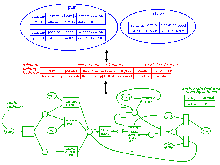
David Bailey's Research Page
What do words like push and pull really mean?
And how do children learn such verbs?
My dissertation research involved modelling children's acquisition of
verb semantics for hand actions. This work is situated at the
crossroads of artificial intelligence, linguistics, psychology,
neuroscience, and connectionist (neural network) modelling. In a
nutshell, I've developed an abstract but plausible model of high-level motor control, and shown
how it can provide the underpinnings of the meanings of verbs like
push, shove, pull, hold and so on, and
similar words from other languages. By studying how biology
constraints meaning, one hopes to explain how children learn words so
quickly, despite the seemingly endless variation across languages.
Want to read more? Check out one of these:
- For the merely curious: a 1-page abstract (1997).
- For the moderately interested: a 6-page
introductory paper from CogSci (1997).
- Looking to the future: a 6-page paper describing some extensions from CogSci
(1998).
- For the masochistic: my 205-page dissertation (1997). This is also available as ICSI
Technical Report 97-041. Slides from my dissertation talk are also
available in full size or miniature.
- For the hands-on crowd: Take a look at the source code. Or download the system to install a copy on
your own computer.
- For the historically-inclined: a 15-page
paper presented at ICLA (1995).
 I am part of the Neural Theory of Language Project
(formerly "L0"), directed by Jerry
Feldman and George
Lakoff. (My other committee members are Robert Wilensky and Dan
Slobin.) For an overview of the language modelling work of our group
at ICSI, see "L0: The First
Five Years".
I am part of the Neural Theory of Language Project
(formerly "L0"), directed by Jerry
Feldman and George
Lakoff. (My other committee members are Robert Wilensky and Dan
Slobin.) For an overview of the language modelling work of our group
at ICSI, see "L0: The First
Five Years".
My colleague Srini Narayanan
is busy showing the connection between motor control like
representations and more abstract forms of thought.
For the next few years, the baton has been passed to graduate students
Nancy Chang, David Andre, Masha Brodsky, Carol Bleyle and
others.
An earlier project of mine involved inference through imagery in the
domain of spatial prepositions, as an extension to Terry
Regier's thesis on acquisition of spatial terms.
 I am part of the Neural Theory of Language Project
(formerly "L0"), directed by Jerry
Feldman and George
Lakoff. (My other committee members are Robert Wilensky and Dan
Slobin.) For an overview of the language modelling work of our group
at ICSI, see "L0: The First
Five Years".
I am part of the Neural Theory of Language Project
(formerly "L0"), directed by Jerry
Feldman and George
Lakoff. (My other committee members are Robert Wilensky and Dan
Slobin.) For an overview of the language modelling work of our group
at ICSI, see "L0: The First
Five Years".
